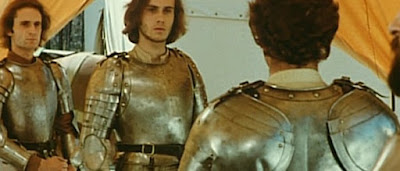 Gertrud
Gertrud
d. Carl Theodor Dreyer, 1964
Gertrud, Carl Theodor Dreyer's final film, is something very rare. There's never been a film like it, and there probably won't be another. Mostly composed of long takes of conversations, Dreyer creates an unnervingly poignant observation on memory and free will, among other things.
The title character, Gertrud, is an ex-opera singer now living with her attorney husband, Gustav, who plans to become a politician. In the astonishing opening scene, we hear them discuss her plans for the night, his mother shows up to pick up her weekly check, and Gerturd finally announces that she wants to leave him. Gustav's indifference towards her is her focus during her monologue.
In the next scene, we see Gertrud talking to her musician lover, Erland, in the park (in the first scene, she told Gustav she was spending her aftrenoon at the opera). Erland tells Gertrud he must go to a party tonight, to which she responds, rather surprisingly, by telling him that he is runining himself and his art by going to parties. This is shocking, not because of its nature, but because in the scene just before it she was condemning Gustav for focusing too much on his work and not on whether she was happy or sad.
There is a scene, following the one in the park, which shows Gustav going to the opera to be with Gertrud, only to realize she has lied to him. This gives way to the centerpiece of the film, a ceremony for renowned poet Gabriel Lidman, who was also once Gertrud's lover. Gustav will be speaking at the ceremony and Erland is scheduled to play. By now we realize the main characters are her and the three men. But Dreyer takes the oppurtunity to introduce a fourth man, a gentle doctor that converses with Gertrud when she walks out on Gustav's speech because of a headache. The doctor, Axel, tells her that he has come back from Paris, he tells her he has written a book on free will.
When Axel leaves, the second scene with Gustav takes place. They argue about their relationship; about Gertrud's reasons for leaving him and of her previous lovers. Then comes the first encounter with Gabriel, the poet, who confesses to have longed for her and speaks of his dissolusioned state, despite all of his success.
There is a second scene with Erland, where he announces that he has a girlfriend who is pregnant, and his relationship with Gertrud ends on a sour note. Not very happy, she goes back home to find that Gabriel is there to visit Gustav. As a final plead, Gabriel asks Gertrud to leave with him, and she remembers a time when she loved him and the exact moment when she stopped - she found a drawing of her on his desk, it read "a man's work and a woman's love are mortal enemies."
After bidding farewell to Gustav and Gabriel comes the final hallucinatory scene, which appears to take place 30-40 years after most of the action in the film. We see Gertrud being visited by her old friend Axel, they speak of the times they had in Paris (though not shown in the film, the viewer assumes she left for Paris after her talk with Gabriel). In the last heartbreaking moment, she reads to him a poem she wrote when she was 16:
"Just look at me
Am I beautiful?
No, but I have loved
Just look at me
Am I young?
No, but I have loved
Just look at me
Do I live?
No, but I have loved."


















